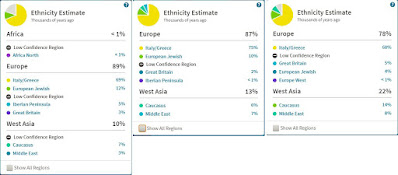All my life I've called myself a purebred because my heritage is only Italian.
 |
| I'm Italian alright. |
To prove that point, my family tree—excluding my many in-law tangents—has only Italian names.
DNA makes our ancestry research an entirely new ball game. What's imprinted on our chromosomes dates back to the origins of man. We can trace our ethnic makeup back thousands of years with an inexpensive DNA test.
All the corners of the earth were not populated on Day One. Those who became native Italians had to come from somewhere else.
Testing both of my parents helps me see which one contributed what to my DNA makeup. Here are the specifics. If you test any set of parents and their child, you can do a similar comparison.
 |
| Side-by-side comparison of Dad, me, Mom. |
- My ethnicity estimate includes 13% West Asian split between the Caucasus and the Middle East. It also includes 10% European Jewish. The rest is almost entirely Italian, or technically "Italy/Greece".
- My dad's ethnicity estimate has less West Asian than I do and more European Jewish than I do.
- My mom's ethnicity estimate has much more West Asian than I do and a lot less European Jewish than I do.
Since my dad's West Asian parts are classified as a "Low Confidence Region", I'm statistically more likely to have gotten those parts from my mom. And since his European Jewish parts are three times higher than my mom's, I'm statistically more likely to have gotten those parts from him.
The part that tickles me the most is that I have a higher percentage of Italy/Greece than either of my parents! That's one of the fascinating things about DNA. You inherit a completely random 50% of your DNA from each parent.
Since I didn't inherit all of their smaller-percentage ethnicities, I am more Italian than they are.
Now take a look at my husband's DNA. One of us is truly a purebred, and it most certainly is not me.
 |
| Another website goes further than Ancestry. My husband is 100% Japanese. |
You may also enjoy these DNA/migration-related articles:


